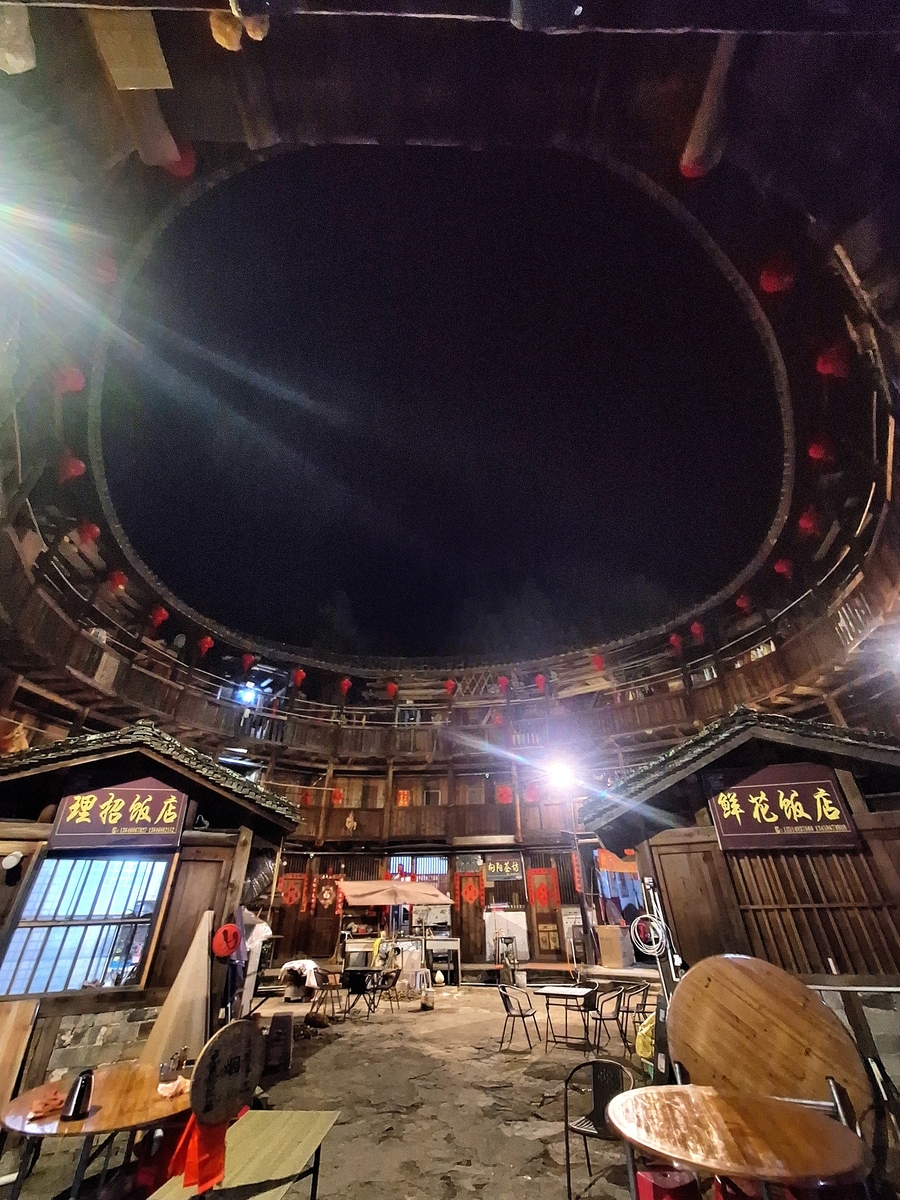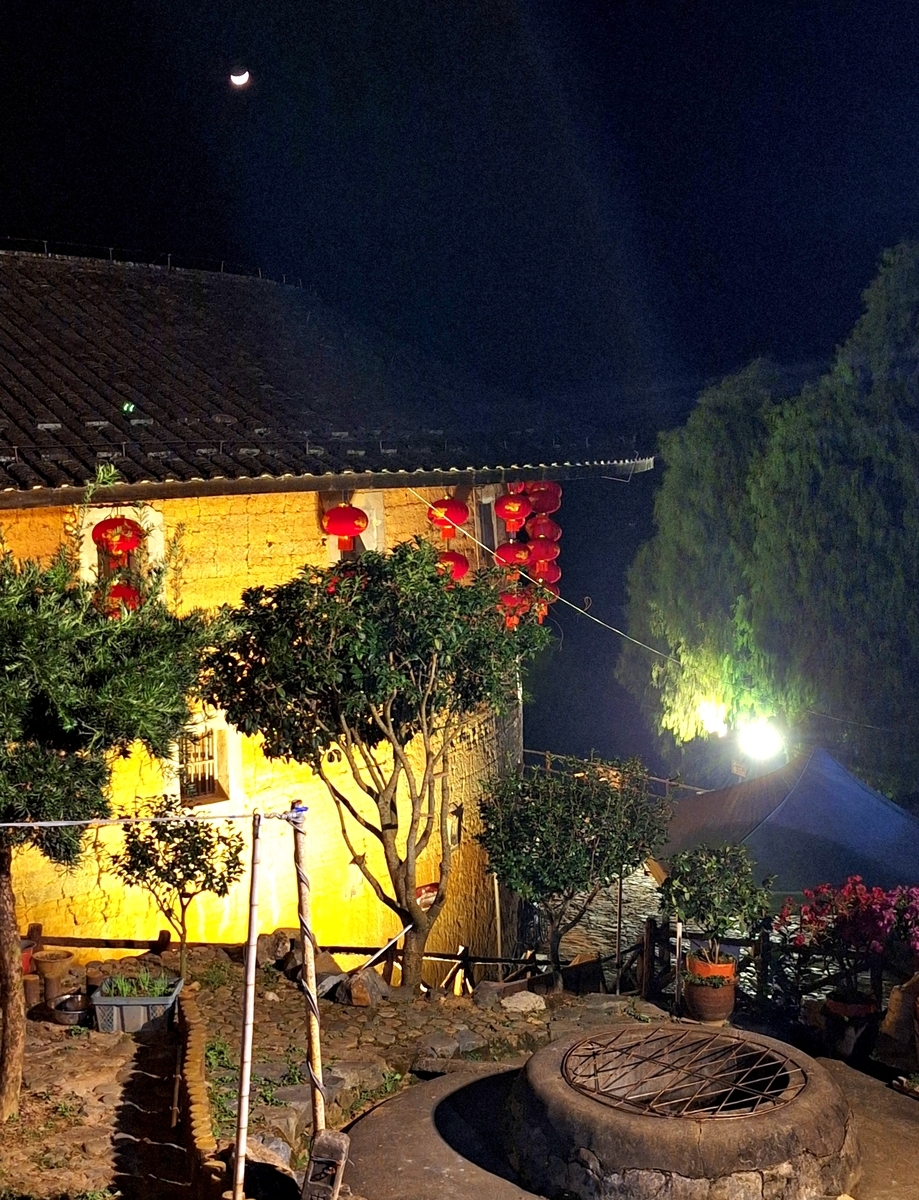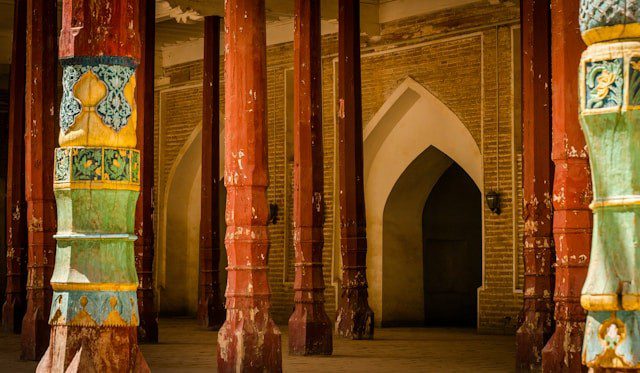
Aerial view of Tianluokeng Tulou cluster. From bottom to top: Wenchang Lou, Zhenchang Lou, Buyun Lou, Duanyun Lou, and Hechang Lou.
In the previous article, I shared my check-in experience and interior exploration of Wenchang Lou. This time, I’ll report on my tour of all five Tulou buildings in the Tianluokeng cluster, known as “Four Dishes and One Soup.” Since I visited on a Friday, there were relatively few tourists, allowing me to explore at a leisurely pace.
Previous article
Wenchang Lou

Let’s start with Wenchang Lou, where I stayed. Built in 1966, this Tulou is relatively young but boasts the largest size in the Tianluokeng cluster. Its most distinctive feature is its globally rare oval shape. Located at the southwestern and lowest position in the cluster, its unique form has captivated many photographers over the years.
The oval shape is said to combine the spaciousness of circular Tulou with the practicality of square ones. Indeed, the courtyard is quite spacious, with cool breezes flowing through in the evening. According to residents, this shape also makes the building less susceptible to typhoon winds.

Dining tables are arranged around the well located almost in the center of the courtyard, with kitchen sinks—the residents’ lifeline—arranged in a circle on the outer edge. Each generation seems to be assigned one sink, which they use for cooking, hand washing laundry, brushing teeth, and washing dishes. Well water was once the only source of running water, but now plumbing extends to the sinks, and water flows with the turn of a faucet.

Each household has a sink around the outer edge of the courtyard.
Ms. Huang, who showed me to my room, suggested I take a walk until dinner preparations were complete, so I decided to step outside Wenchang Lou and explore the other Tulou buildings.
Zhenchang Lou

Walking up a gentle slope from Wenchang Lou, I arrived at Zhenchang Lou, a compact circular Tulou. Built in 1930, this Tulou is notable for having two restaurants in its courtyard in addition to the residents’ basic facilities.

The symmetrical courtyard
These restaurants with modern amenities are popular with tourists and serve Hakka cuisine. Although I had planned to have dinner at Wenchang Lou this time, locals told me that the traditional stir-fry dishes using camellia oil are exceptional here.

Yams scattered around the courtyard (apologies for the out-of-sequence photos)
The courtyard was filled with yams that appeared to have been harvested from nearby fields, with a refrigerator standing nearby. When I visited in the morning, I noticed breakfast food that had apparently been prepared the night before boldly left out at the courtyard sinks, providing a visible glimpse into residents’ daily lives (though I was a bit concerned about food safety).

The local style of leaving prepared food outdoors. This demonstrates their absolute trust in the Tulou’s ability to keep outsiders away (although tourists can now freely enter)
Interestingly, all five Tulou buildings are inhabited by families with the surname Huang (which made it a bit challenging to address residents individually). These people, who share the same ancestors, still share a common surname and have bonds that transcend mere cohabitation.

Buyun Lou

Climbing further up the stone steps, I came upon Buyun Lou, the only square Tulou in the Tianluokeng cluster. Built in 1796, it’s the oldest of the five buildings and features an impressive Buddhist altar at the back when viewed from the entrance.

The courtyard was piled high with colorful fruits, which were items for sale to tourists though they had an atmosphere almost like religious offerings. This Tulou also featured souvenir shops and art galleries, making it well-equipped for tourism.

At dusk, I was fortunate to be guided up to the third floor through the special kindness of a tea shop owner. The view of the sunset behind the mountains and the Tulou cluster below was breathtaking. I’ll share more about my interaction with the shop owner on another occasion.

Outside Buyun Lou, vegetables, tea leaves, and medicinal herbs like angelica and cinnamon were drying (though they seemed to be absorbing moisture from the heavy fog). The fact that important food items and trade goods were left unprotected outdoors speaks to the excellent security in the area.
Ruiyun Lou

Next to Buyun Lou stands Ruiyun Lou, built in 1936. Though a relatively small circular Tulou, it’s still home to many residents.

Glowing red in the center of Ruiyun Lou’s courtyard is a large ancestral shrine. Rather than a Buddhist altar for worshipping Buddha, this is a place to honor the ancestors of the families living in the Tulou. As mentioned earlier, each Tulou or Tulou cluster is typically inhabited by families sharing the same surname (in the Tianluokeng cluster, the Huang family), and the shrine within the Tulou serves as an important spiritual center for them. It was impressive to see residents taking turns offering incense every morning, carefully preserving this tradition.

Along the path connecting the Tulou buildings, I came across a large communal well. According to locals, this well predates the formation of the Tulou cluster and was once an important water source for residents in the area. It’s still used for domestic water and has become a symbol of the Tulou cluster.
Hechang Lou

Situated at the highest point in the Tianluokeng cluster is Hechang Lou. Built in the same year as Buyun Lou, this beautifully circular building now serves as a peaceful tourist attraction, but at the time of its construction, lookouts from this high vantage point played an important role in guarding against bandits who targeted the wealth of returning overseas Chinese.

A local glutinous rice wine shop that resembles a granary, with buckets full of fermenting rice wine. The hygiene conditions looked somewhat concerning (though I later enjoyed the delicious wine)
Entering the Tulou, an eye-catching glutinous rice wine shop dominated the courtyard. Several large buckets were lined up in front of the shop, fermenting glutinous rice harvested in the region. Inside the buckets, the brownish wine base gave off a sweet aroma as it slowly fermented. I’ll share more about the taste of this traditional glutinous rice wine, along with my drinking experience, on another occasion.

Outside Hechang Lou, loofah gourds were drying alongside residents’ shoes. In Japan, loofahs were once used as sponges, and in this region too, they are valued as dishwashing sponges.
What Did You Think?

Besides the five Tulou buildings, the Tianluokeng cluster is dotted with accommodations and restaurants.
In this article, I’ve introduced the five Tulou buildings that make up the Tianluokeng cluster. In the next installment, I’ll share my experiences exploring outside the Tulou, how I spent the evening at Wenchang Lou, and my experiences until the following morning. There are still many fascinating experiences to share, including unexpected interactions with residents and the atmosphere of the Tulou at night.
Next article
![[Hourly Stays Available] Best Place for a Nap During a Shanghai Layover: Shanghai Dazhong Airport Hotel Review – Ultimate Convenience!](https://en.kosupatravel.com/wp-content/uploads/2025/04/20240818080110.jpg)





Pingback: [Fujian Tulou at Night] Midnight Stroll to a Scenic Viewpoint Overlooking Tianluokeng Tulou Cluster – Stay Experience Part 4 - Kosupa Travel